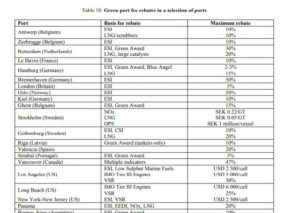A new Organisation for Economic Co-operation and Development International Transport Forum report argues ports need to develop more and sma rter incentives to meet the International Maritime Organisation’s greenhouse gas (GHG) targets for the shipping sector
rter incentives to meet the International Maritime Organisation’s greenhouse gas (GHG) targets for the shipping sector
Reducing Shipping Greenhouse Gas Emissions: Lessons From Port-Based Incentives includes a global summary of 28 ports with environmentally-based port fees and stresses that currently, there is very limited information available on the impact of port-based incentives and significant positive effects of incentives are limited. Author Olaf Merk concluded: “It is fairly safe to say that the effectiveness of port-based incentives to reduce maritime GHG emissions remains pretty marginal.” However, he added that wider application of the principles behind the measures “could have huge potential” and incentives could have more impact if they “were wider applied, if the financial incentives were larger, if the schemes stimulated technological innovation, if schemes focused on carbon, and if they could become more harmonised.”
Unseen benefits – Looking at green port fees, he said that a “fairly marginal share” of the ships calling at ports with green port fees actually get a deduction of the port fee.
The impact of green port fees on shipping’s GHG emissions is negligible, as the indicators in which CO2 emissions have substantial weight (CSI and RightShip) are only used by five ports, Mr Merk stated. Plus, there is a need to apply the polluter principle via a system of environmentally differentiated port fees, applied to all ships, not just a rebate for the greenest ships.
More focus needed – The report pointed out incentives could be aligned more closely to actual GHG emissions from ships. None of the green port fees takes actual GHG emissions as a base for the fee reduction currently. As most shipping companies use a network of ports, the effect of a green port fee would be much higher if all ports in the network applied it, Mr Merk said.
“An effective mechanism might consist of a harmonised index or score assigned to all ships, taken as the basis in all ports for a differentiated port fee, and used by shippers in their reporting on the carbon footprint of their supply chain,” he stated.
Vessel speed reduction schemes for ships near port areas are generally considered to be effective instruments found in the report. The participation from shipping companies has been very high: according to the Port of Long Beach Compliance Report for the year 2016.
Green berth allocation virtual arrival policies could also bring large benefits in terms of emission reductions.
Source: Port Strategy

